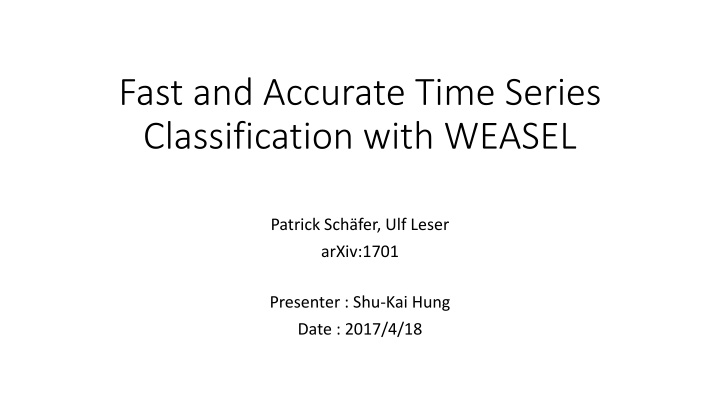
Fast and Accurate Time Series Classification with WEASEL
Learn about WEASEL, a scalable and accurate method for time series classification, which transforms time series into feature vectors using a unique approach. WEASEL outperforms current methods in accuracy and scalability, making it ideal for large datasets and real-world applications like smart grids.
Download Presentation

Please find below an Image/Link to download the presentation.
The content on the website is provided AS IS for your information and personal use only. It may not be sold, licensed, or shared on other websites without obtaining consent from the author. If you encounter any issues during the download, it is possible that the publisher has removed the file from their server.
You are allowed to download the files provided on this website for personal or commercial use, subject to the condition that they are used lawfully. All files are the property of their respective owners.
The content on the website is provided AS IS for your information and personal use only. It may not be sold, licensed, or shared on other websites without obtaining consent from the author.
E N D
Presentation Transcript
Fast and Accurate Time Series Classification with WEASEL Patrick Sch fer, Ulf Leser arXiv:1701 Presenter : Shu-Kai Hung Date : 2017/4/18
Abstract(1/2) Time series (TS) occur in many scientific and commercial applications, ranging from earth surveillance to industry automation to the smart grids. An important type of TS analysis is classification, which can, for instance, improve energy load forecasting in smart grids by detecting the types of electronic devices based on their energy consumption profiles recorded by automatic sensors. Such sensor-driven applications are very often characterized by (a) very long TS and (b) very large TS datasets needing classification. However, current methods to time series classification (TSC) cannot cope with such data volumes at acceptable accuracy, they are either scalable but offer only inferior classification quality, or they achieve state-of-the-art classification quality but cannot scale to large data volumes.
Abstract(2/2) In this paper, we present WEASEL (Word ExtrAction for time SEries cLassification), a novel TSC method which is both scalable and accurate. Like other state-of-the-art TSC methods, WEASEL transforms time series into feature vectors, using a sliding-window approach, which are then analyzed through a machine learning classifier. The novelty of WEASEL lies in its specific method for deriving features, resulting in a much smaller yet much more discriminative feature set. On the popular UCR benchmark of 85 TS datasets, WEASEL is more accurate than the best current non-ensemble algorithms at orders-of-magnitude lower classification and training times, and it is almost as accurate as ensemble classifiers, whose computational complexity makes them inapplicable even for midsize datasets. The outstanding robustness of WEASEL is also confirmed by experiments on two real smart grid datasets, where it out-of-the-box achieves almost the same accuracy as highly tuned, domain-specific methods.
Bag-of-Pattern Symbolic Aggregate approXimation (BOP) Sample => time series Window => fixed length Discretization Symbolic Aggregate approximation (SAX ) Bag-of-Pattern model Count
Symbolic Aggregate approximation(SAX ) 1.0 c c c b 0.5 b 0.0 a a -0.5
WEASEL(Word ExtrAction for time SEries cLassification) 1. Discriminative feature generation : determines discriminative Fourier coefficients using the ANOVA f-test & information gain 2. Co-occurring words : local order is encoded into the model(bi-gram). 3. Variable-length windows : Not fixed length 4. Feature selection : Use Chi-Squared test to be filter BOP feature space is O(??), word length ? and ? symbols WEASEL : bi-gram + variable length(n) => space O(?2? ?),
one one- -way ANOVA F way ANOVA F- -test test F-value is then defined as: F = ??? between, ???= mean square within. ???, ???: mean square If there is no difference between the group means, the F-value is close to or below 1. Quantization : information gain
Chi-square 22 18 40 30 10 40 33 27 60 25 35 60 55 45 100 55 45 100 (N=100) 1 Model 2 Ho ( ) 3 55 * 60/100 = 33 4 (30 22)2/22 + (10 18)2/18 + (25 33)2/33 + (35 27)2/27 = 10.78 > 3.84 (df) : (r-1)*(c-1) 2*2 Gamma 3.84
